.jpeg)
CES-Schools
The sun rises on the BYU–Idaho campus and the Rexburg Idaho Temple in Rexburg on September 23, 2019. Photo by Jeffrey D. Allred, courtesy of Church News.All rights reserved.This story appears here courtesy of TheChurchNews.com. It is not for use by other media.
By Rachel Sterzer Gibson, Church News
When talking about education in the Church, Elder Clark G. Gilbert will often share a scripture that in countless ways has defined his time, attention and efforts for many years.
In his role as president of BYU–Idaho, then as president of BYU–Pathway Worldwide and now as a General Authority Seventy who will assume the role of commissioner of the Church Educational System, Elder Gilbert has thought deeply about how to overcome the challenge posed in 3 Nephi 6:12, where the Nephites begin to have distinctions based on their riches and “their chances for learning.” The verse states that “some were ignorant because of their poverty, and others did receive great learning because of their riches.”
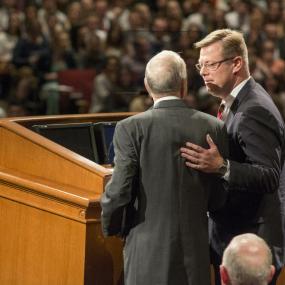
CES-Schools
Elder Russell M. Nelson of the Quorum of the Twelve Apostles introduces Brigham Young University–Idaho’s newest president, Clark G. Gilbert, on January 27, 2015. Photo by Ryan Chase, courtesy of Church News.All rights reserved.Through the years, the Church has continued to strive to increase Latter-day Saints’ “chances for learning,” establishing schools, academies, colleges and universities.
Part of the remarkable story of the Church Educational System today is that all members of The Church of Jesus Christ of Latter-day Saints have a chance to be successful in school regardless of their station in life, previous academic experiences or their access to education, Elder Paul V. Johnson told the Church News prior to being released as Church commissioner of education. Elder Johnson’s appointment to the Presidency of the Seventy was announced in the April 2021 general conference. “There are opportunities for everyone to be blessed by at least one of the institutions of CES.”
How is this possible with Church members strewn across continents and representing a variety of cultures and circumstances? Fortunately, the Church Educational System is equipped with some special tools within its toolbox. Brigham Young University, BYU–Idaho, BYU–Hawaii, Ensign College and BYU–Pathway Worldwide, like a hammer, screwdriver or socket wrench, all serve an important but different role within the overall mission of CES.
“Sometimes you’ll look at university systems, and they’re all basically replications of themselves,” Elder Gilbert said during an interview with the Church News. “But in the Church Educational System, we really have five distinct higher education organizations with very distinctive roles and very distinctive strategies.”
Elder Gilbert described BYU as the ambassador, Ensign College as the applied curriculum developer, BYU–Hawaii as the Pacific capstone, BYU–Idaho as the teacher and BYU–Pathway Worldwide as the access provider.
BYU: The Ambassador
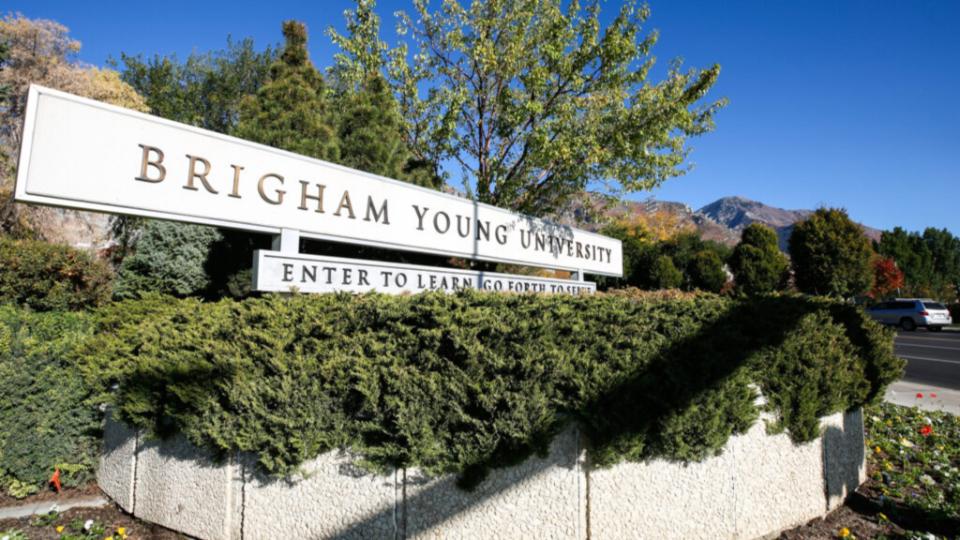
CES-Schools
The Brigham Young University campus in Provo, Utah, is pictured on Monday, October 12, 2020. Photo by Yukai Peng, courtesy of Church News.All rights reserved.Founded in 1875, BYU is the oldest of the CES institutions. It’s also the largest and most recognized. With high-profile industry and government collaborations, top-ranked NCAA athletic programs, and performance groups that tour the globe, BYU is the most widely known outside of the Church. It also plays a distinctive role in bringing together external audiences and providing insight on topics where the Church has unique capacity to impact the world.
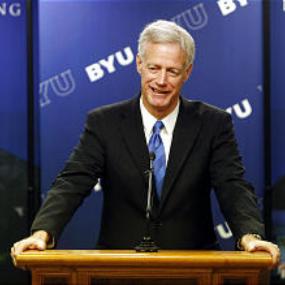
CES-Schools
Kevin J. Worthen speaks during a press conference in Provo, Utah, March 11, 2014, after it was announced that he is to become Brigham Young University’s 13th president. Photo by Ravell Call, courtesy of Church News.All rights reserved.BYU President Kevin J. Worthen called it “the flagship higher education institution” of the Church. “Brigham Young University is a faith-based institution that strives to be among the exceptional universities in the world and an essential university for the world,” he said.
The university’s main campus sits on roughly 560 acres and includes more than 300 buildings. The sprawling campus is flanked by the Wasatch Mountains to the east, and to the west is Provo city and the 23-mile-long Utah Lake. It has two satellite locations: one in Jerusalem and another in Salt Lake City.
It serves more than 45,000 students from 103 countries and all 50 states. It’s the only research-focused university within the CES stable and the only one to offer both graduate and doctoral degrees — 88 master’s degrees and 32 doctoral degree programs, to be exact, said President Worthen.
BYU is also the most academically competitive of the Church universities. According to its website, BYU has a 59% acceptance rate among its freshmen.
The university has a responsibility, President Worthen said, “to provide wide and deep engagement with the world through faculty scholarship, experiential learning opportunities both on and off campus, and nationally recognized academic programs.”
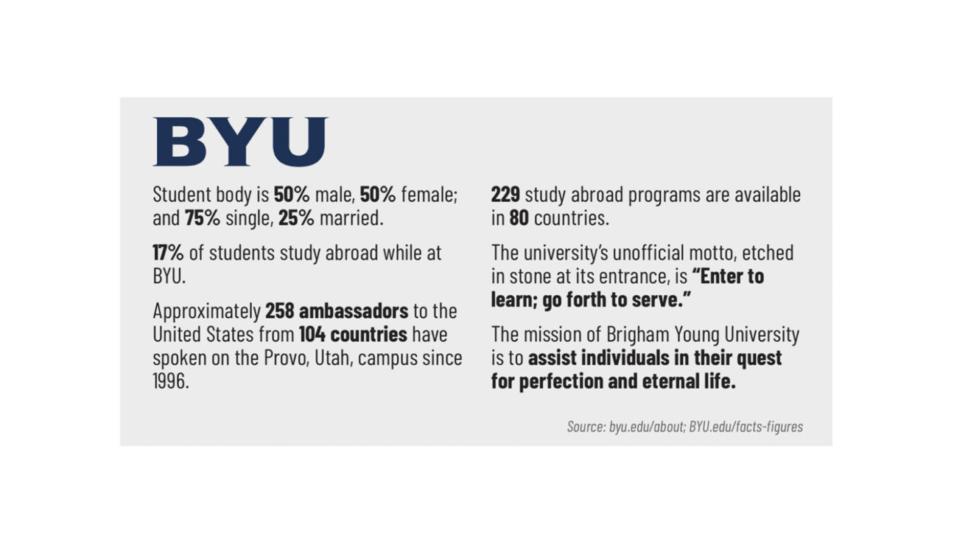
CES-Schools
Statistics about Brigham Young University in Provo, Utah. Graphic courtesy of Church News.All rights reserved.In 2019 it tied with the Naval Academy in a report from The Wall Street Journal as the best in the nation for being worth the cost. And, as a side note, it’s also the only university within the CES to offer a degree in animation.
“Through faith-based teaching and student-centered research, BYU aims to produce students of excellence who make a distinctive and profound impact on the world,” President Worthen said.
Ensign College: Applied Curriculum Developer
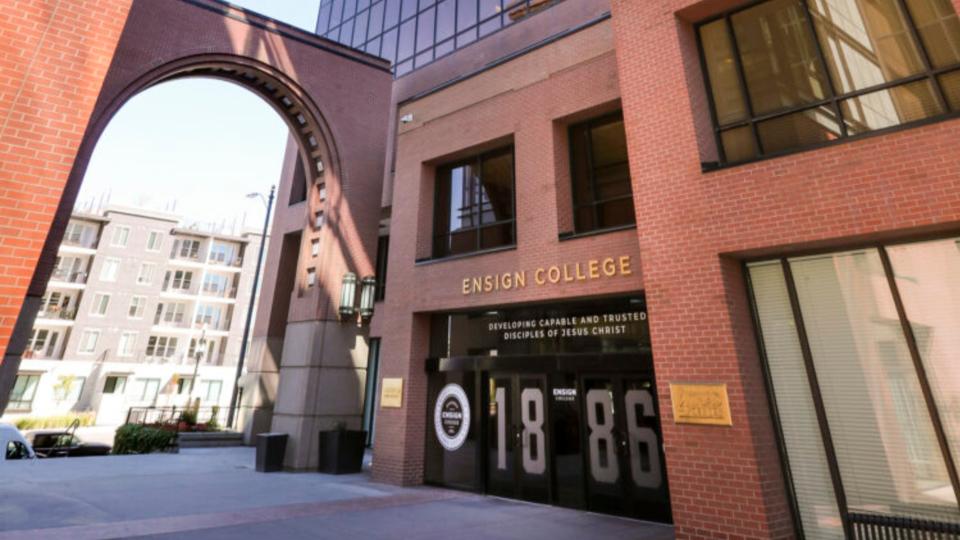
CES-Schools
New signage on the building indicates that LDS Business College is now Ensign College, in Salt Lake City on Tuesday, September 1, 2020. Photo by Scott G Winterton, courtesy of Church News.All rights reserved.Ensign College, which changed its name from LDS Business College less than a year ago, provides a skills-based, applied education, explained its president, Bruce C. Kusch.
In other words, it strives to give students practical, job-ready skills. Graduates should be prepared to earn a working wage quickly after graduation.
The college uses a three-tier curriculum: certificates that can be earned in two semesters, associate degrees that can be earned in two years, and now, starting in the fall, a limited number of Bachelor of Applied Science degrees. “Our degree programs take a certificate-first approach designed to provide students with marketable skills within the first two semesters,” President Kusch said.
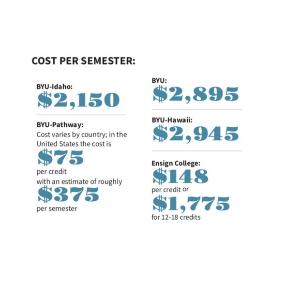
CES-Schools
The cost per semester at the Church Educational System’s five institutions for higher education. Graphic courtesy of Church News.All rights reserved.Ensign College offers a variety of programs, including business, health professions, information technology, software development, interior design, paralegal studies, social media marketing and applied technology.
Serving roughly 2,700 students, the college is located in one of the three buildings that make up the Triad Center in downtown Salt Lake City.
The school’s newest moniker is derived from a spot within close view of where the college is now located — Ensign Peak, where Brigham Young described the vision he had seen of the Salt Lake Valley prior to beginning the pioneer trek west.
The college’s mission is “developing capable and trusted disciples of Jesus Christ.”
“That’s not just a slogan or a nice little phrase,” President Kusch said. “We mean it. I would hope that every single student who comes here leaves better than when they came, and that they have a foundation for being faithful members of the Church for all of their days.”
The intent of an Ensign College education, President Kusch continued, is “to produce graduates who are spiritually well-grounded and professionally prepared to provide a livelihood. We help students become capable and trusted disciples of Jesus Christ by providing a skills-based curriculum in a spiritually nurturing environment.”
The institution has an “open-door” admission policy, meaning “for anyone that is worthy, and willing and qualified, we warmly welcome you to an institution that is a beacon of hope and opportunity,” President Kusch said.
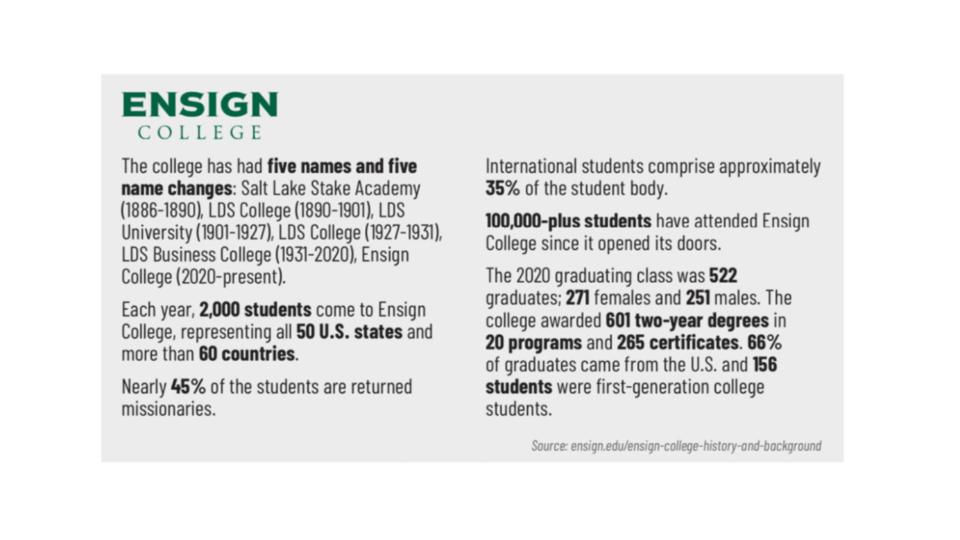
CES-Schools
Statistics about Ensign College. Graphic courtesy of Church News.All rights reserved.Nearly five years ago, the school began implementing a principles-based learning and teaching framework to help immerse students in a real-life learning experience. “It’s been remarkable to see what happens in the life of a student when they accept responsibility for their own learning,” President Kusch said.
BYU–Hawaii: The Pacific Capstone
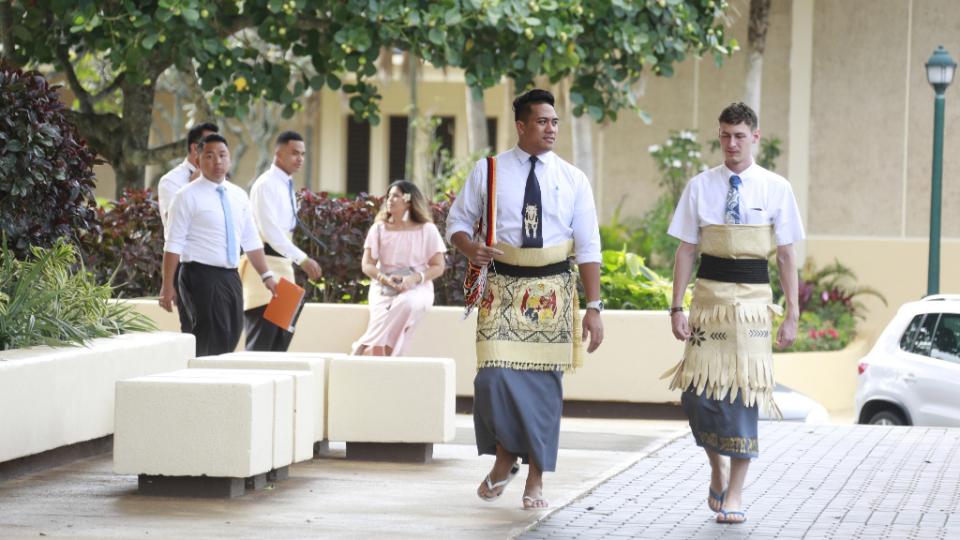
CES-Schools
Young adults walk on the BYU–Hawaii campus on their way to a worldwide devotional broadcast. Photo by Monique Saenz, courtesy of Church News.All rights reserved.Part of what sets BYU–Hawaii apart will always be its lovely location. Situated between the lush, verdant mountains and the turquoise waters of the North Shore of Oahu, the BYU–Hawaii campus covers about 100 acres and lies adjacent to the manicured grounds of the Laie Hawaii Temple and the Polynesian Cultural Center.
Like its sister organization in Provo, BYU–Hawaii exists to assist individuals in their quest for perfection and eternal life. BYU–Hawaii’s mission statement, however, includes the added directive of assisting men and women in their efforts “to influence the establishment of peace internationally.”
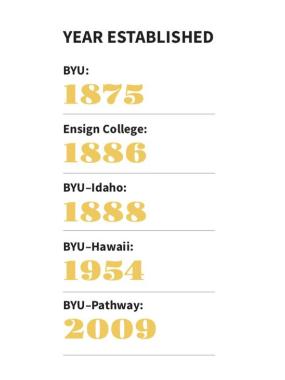
CES-Schools
The year each of the Church Educational System’s five higher education institutions was established. Graphic courtesy of Church News.All rights reserved.According to the Chronicle of Higher Education, BYU–Hawaii has a higher percentage of international students than any other baccalaureate institution in the United States (“U.S. Colleges With the Most International Students,” The Chronicle of Higher Education, Nov. 20, 2009). During the 2019–2020 school year, 48% of the student body were international students, representing 63 countries throughout the Pacific — such as French Polynesia, New Zealand, Samoa and Tonga — and Asia — such as China, Japan, Korea, Mongolia and the Philippines.
The two words BYU–Hawaii President John S.K. Kauwe III would use to describe BYU–Hawaii are “diversity” and “unity.”
“BYU–Hawaii gathers people across countries and kingdoms and creates unity in spiritual and secular education like no other institution on earth,” he said.
The school was established on specific prophetic revelation, he noted. On an inspection tour of missions around the world, Elders David O. McKay and Hugh J. Cannon attended a flag-raising in Laie; then-Elder McKay envisioned a school to make Laie the Church’s spiritual and educational center in the Pacific.
In 1955 during the groundbreaking for the college, President McKay prayed “that this college, and the temple, and the town of Laie may become a missionary factor, influencing not thousands, not tens of thousands, but millions of people who will come seeking to know what this town and its significance are” (“Laie: A Destiny Prophesied,” Ensign, July 1994).
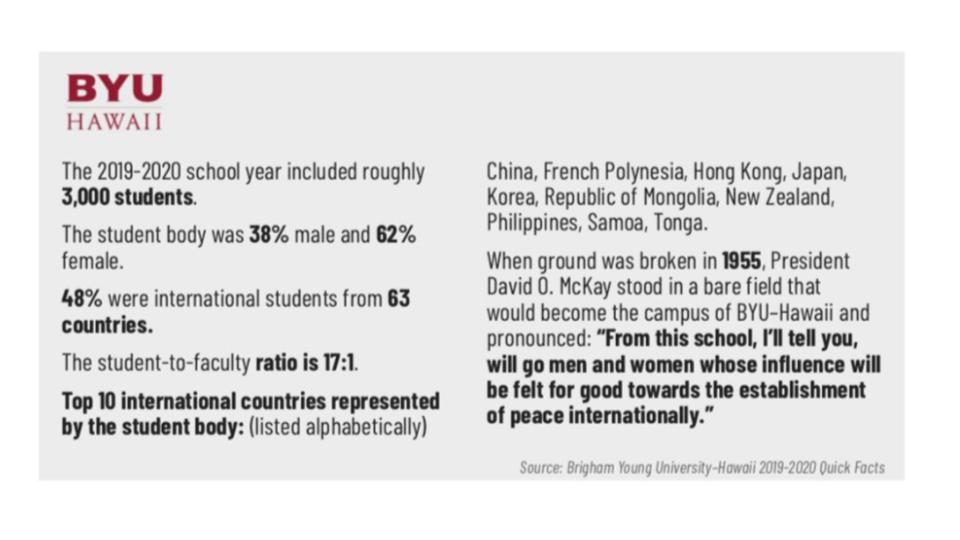
CES-Schools
Statistics about BYU–Hawaii. Graphic courtesy of Church News.All rights reserved.Since the opening of the Polynesian Cultural Center in 1963, over 37 million people have visited Laie. Today, the university continues its symbiotic relationship with the cultural center, which helps to preserve the cultures of the Pacific while providing jobs for students of the college.
According to the university’s website, President McKay also prophesied that the school would produce “leaders — not only on this island but everywhere.”
Part of that prophetic direction is a clear directive to serve the Saints in the Pacific Islands and Asia, President Kauwe said. “This makes BYU–Hawaii a truly unique place where people from across the world gather to be one in Christ and educate and uplift each other.”
BYU–Idaho: The Teacher
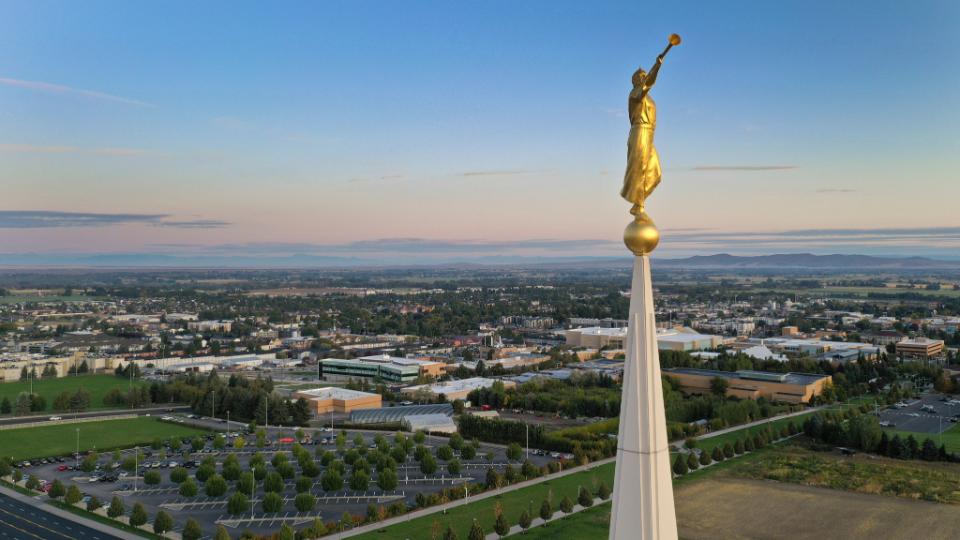
CES-Schools
The BYU–Idaho campus and the Rexburg Idaho Temple on Monday, September 23, 2019. Photo by Jeffrey D. Allred, courtesy of Church News.All rights reserved.In 2000, when President Gordon B. Hinckley announced the transformation of Ricks College from a two-year junior college to Brigham Young University–Idaho, a four-year institution, he said the school would “have a unique role and be distinctive from the other institutions of higher education within the Church Educational System.”
For one thing, the school would stay “teaching oriented,” President Hinckley said.
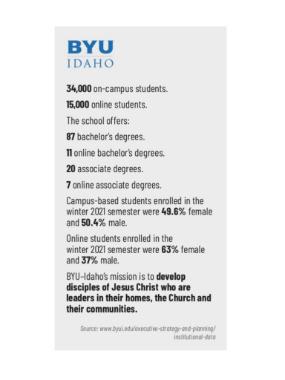
CES-Schools
Statistics about BYU–Idaho. Graphic courtesy of Church News.All rights reserved.“BYU–Idaho’s teachers and administrators are specifically focused on helping students see and strive for their potentials as disciples of Jesus Christ,” said Brett Sampson, BYU–Idaho’s public affairs director.
The university’s goal is to prepare students for lifelong learning, employment and roles as leaders in the home, Church and community.
The school was founded on a cold November day in 1888, when Latter-day Saint pioneers gathered in the newly settled town of Rexburg for the opening of the Bannock Stake Academy.
Since then, the school has steadily grown into the state’s largest private university, with a campus that spans more than 400 acres and over 40 buildings situated on a hill overlooking Rexburg. About 34,000 students attend each year.
The school’s motto is “rethinking education.” That innovative spirit is exemplified in the school’s expanded online offerings, which now include 11 online bachelor’s degrees and seven online associate degrees. It is also reflected in the school’s year-round academic calendar, its student-led mentoring programs and a learning model that encourages students to teach one another and be accountable for their own learning.
“Everything at BYU-Idaho is focused on our students’ success as disciples and leaders,” Sampson said.
During his inaugural address as president of BYU–Idaho in 2015, then-President Gilbert noted, “Since President Hinckley’s announcement, the number of students at BYU–Idaho has tripled even as the relative cost per student has declined — a miracle within the Church, and a model for ‘rethinking education’ more generally.”
President Henry B. Eyring, second counselor in the First Presidency, said that the phrase “rethinking education” is not simply a slogan. “The school is to be a place of educational innovation permanently.”
Past university president and now emeritus General Authority Seventy Elder Kim B. Clark noted in his inauguration that BYU-Idaho is “a very special place, a place that the Lord has preserved and dedicated to be the home of a great university with a very special and distinctive culture.”
Part of that distinctive culture is something referred to as the “Spirit of Ricks,” which Sampson called a “defining characteristic” of BYU–Idaho.
But what is the “Spirit of Ricks”? Elder David A. Bednar of the Quorum of the Twelve Apostles, who guided the college through its transition to a university during his tenure as school president, explained, “The ‘Spirit of Ricks’ suggests the spirituality, the desire for obedience, the personal caring and warmth, the humility and modesty, the friendliness and genuine concern for others, the bright smiles and cheerful hellos, and so many other elements that make this university an unusually inviting and supporting and nurturing institution” (Thomas E. Ricks Building Dedication, Feb. 18, 2005).
BYU–Pathway Worldwide: The Access Provider

CES-Schools
BYU–Pathway Worldwide virtual gatherings were implemented worldwide in response to the COVID-19 outbreak. Photo courtesy of BYU–Pathway Worldwide.All rights reserved.The most recent innovation to the Church Educational System is BYU–Pathway Worldwide, which is increasing Latter-day Saints’ “chances for learning” like never before. As the Church’s online program, BYU–Pathway is bringing education to women and men who would never be able to set foot on a college campus.
What makes BYU–Pathway distinctive can really be boiled down to two things, Elder Gilbert said: who they serve and where they serve.
BYU–Pathway Worldwide caters to the “hidden many,” or members of the Church who never thought that college was for them — which, in reality, turns out to be a lot. More than 55% of Latter-day Saints in the U.S. and 85% to 90% in the international Church don’t have a degree.
This hidden many can be broken into three groups, Elder Gilbert said. The first group consists of younger students who don’t have the confidence or academic background to start college. “They say to themselves, ‘I’m not college material,’ and we show them, ‘Yes, you are.’”
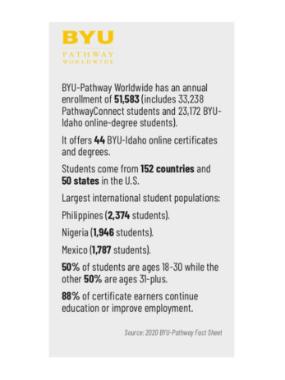
CES-Schools
Statistics about BYU–Pathway Worldwide Graphic courtesy of Church News.All rights reserved.The second group is made up of “stop outs”: people who started college and didn’t complete it for some reason, Elder Gilbert explained. The third group is adult learners who think they’ve missed their window. They typically work, have families and have Church responsibilities, and they don’t think it’s possible to go to school.
“We’ve designed BYU–Pathway specifically for these populations,” Elder Gilbert said.
The second thing that makes BYU–Pathway unique within the CES is its reach. “The whole program is designed to be online,” President Gilbert said. “BYU–Pathway was designed to operate wherever the Church is organized. You don’t have to come to campus, it’s not geographically dependent, and the program works in West Africa, in the Philippines and in South Jordan, Utah.”
By designing the program to be affordable, flexible, accessible and to build confidence, BYU–Pathway has removed barriers for the hidden many to begin pursuing education, whether it be a certificate or degree. “Over half of our students who complete a certificate get a job improvement immediately, even before they finish their bachelor’s degree,” Elder Gilbert said.
In the 10-plus years since it launched, BYU–Pathway has steadily expanded. In 2020, enrollment reached 50,000 students in 150 countries. The online university saw record enrollment, even through the pandemic.
In a Church News podcast in January, Elder Gilbert expressed his belief that BYU–Pathway “will just keep expanding because the need is so great across the Church, and traditional educational models don’t work for most people. So the affordability, the online nature, the flexible schedule and the spiritual competence you’ve gained through the program all have made it really transformative.”
Building Strong Disciples
Although each school within the CES portfolio has a distinctive contribution to make to the whole Church Educational System, Elder Gilbert said they also all have a “unifying purpose and mission to develop disciples of Jesus Christ who can be leaders in the Church, in their homes and in their workplaces.”
The work that each institution is doing to increase Latter-day Saints’ chances for learning — both secularly and spiritually — is an important part of the work of the Lord. In the Church News podcast, Elder Gilbert said: “I fundamentally believe [the Lord is] preparing the world for the return of the Savior. And part of that is the work He’s doing to gather His Church by building capacity and leadership through education all across the world.”
Copyright 2021 Deseret News Publishing Company
